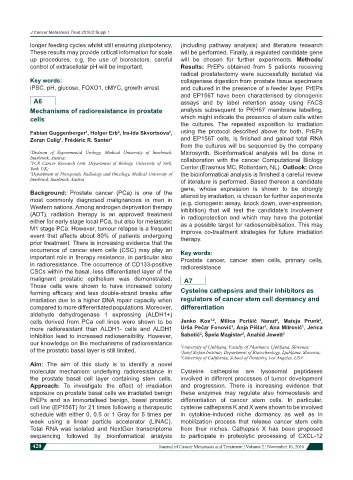Page 430 - Read Online
P. 430
J Cancer Metastasis Treat 2016;2 Suppl 1
longer feeding cycles whilst still ensuring pluripotency. (including pathway analysis) and literature research
These results may provide critical information for scale will be performed. Finally, a regulated candidate gene
up procedures, e.g. the use of bioreactors, careful will be chosen for further experiments. Methods/
control of extracellular pH will be important. Results: PrEPs obtained from 5 patients receiving
radical prostatectomy were successfully isolated via
Key words: collagenase digestion from prostate tissue specimens
iPSC, pH, glucose, FOXO1, cMYC, growth arrest and cultured in the presence of a feeder layer. PrEPs
and EP156T have been characterised by clonogenic
A6 assays and by label retention assay using FACS
Mechanisms of radioresistance in prostate analysis subsequent to PKH67 membrane labelling,
cells which might indicate the presence of stem cells within
the cultures. The repeated exposition to irradiation
2
1
Fabian Guggenberger , Holger Erb , Ira-Ida Skvortsova , using the protocol described above for both, PrEPs
3
Zoran Culig , Frédéric R. Santer 1 and EP156T cells, is finished and gained total RNA
1
from the cultures will be sequenced by the company
1 Division of Experimental Urology, Medical University of Innsbruck, Microsynth. Bioinformatical analysis will be done in
Innsbruck, Austria; collaboration with the cancer Computational Biology
2 YCR Cancer Research Unit, Department of Biology, University of York,
York, UK; Center (Erasmus MC, Rotterdam, NL). Outlook: Once
3 Department of Therapeutic Radiology and Oncology, Medical University of the bioinformatical analysis is finished a careful review
Innsbruck, Innsbruck, Austria of literature is performed. Based thereon a candidate
gene, whose expression is shown to be strongly
Background: Prostate cancer (PCa) is one of the altered by irradiation, is chosen for further experiments
most commonly diagnosed malignancies in men in (e.g. clonogenic assay, knock down, over-expression,
Western nations. Among androgen deprivation therapy inhibition) that will test the candidate’s involvement
(ADT), radiation therapy is an approved treatment in radioprotection and which may have the potential
either for early stage local PCa, but also for metastatic as a possible target for radiosensibilisation. This may
M1 stage PCa. However, tumour relapse is a frequent improve co-treatment strategies for future irradiation
event that affects about 80% of patients undergoing therapy.
prior treatment. There is increasing evidence that the
occurrence of cancer stem cells (CSC) may play an Key words:
important role in therapy resistance, in particular also Prostate cancer, cancer stem cells, primary cells,
in radioresistance. The occurrence of CD133-positive radioresistance
CSCs within the basal, less differentiated layer of the
malignant prostatic epithelium was demonstrated. A7
Those cells were shown to have increased colony
forming efficacy and less double-strand breaks after Cysteine cathepsins and their inhibitors as
irradiation due to a higher DNA repair capacity when regulators of cancer stem cell dormancy and
compared to more differentiated populations. Moreover, differentiation
aldehyde dehydrogenase 1 expressing (ALDH1+)
2
1,2
2
cells derived from PCa cell lines were shown to be Janko Kos , Milica Perišič Nanut , Mateja Prunk ,
1
1
1
more radioresistant than ALDH1- cells and ALDH1 Urša Pečar Fonović , Anja Pišlar , Ana Mitrović , Jerica
2
2
inhibition lead to increased radiosensibility. However, Sabotič , Špela Magister , Anahid Jewett 3
our knowledge on the mechanisms of radioresistance 1 University of Ljubljana, Faculty of Pharmacy, Ljubljana, Slovenia;
of the prostatic basal layer is still limited. 2 Jožef Stefan Institute, Department of Biotechnology, Ljubljana, Slovenia;
3 University of California, School of Dentistry, Los Angeles, USA
Aim: The aim of this study is to identify a novel
molecular mechanism underlying radioresistance in Cysteine cathepsins are lysosomal peptidases
the prostate basal cell layer containing stem cells. involved in different processes of tumor development
Approach: To investigate the effect of irradiation and progression. There is increasing evidence that
exposure on prostate basal cells we irradiated benign these enzymes may regulate also homeostasis and
PrEPs and an immortalised benign, basal prostatic differentiation of cancer stem cells. In particular,
cell line (EP156T) for 21 times following a therapeutic cysteine cathepsins K and X were shown to be involved
schedule with either 0, 0.5 or 1 Gray for 5 times per in cytokine-induced niche dormancy as well as in
week using a linear particle accelerator (LINAC). mobilization process that release cancer stem cells
Total RNA was isolated and NextGen transcriptome from their niches. Cathepsin X has been proposed
sequencing followed by bioinformatical analysis to participate in proteolytic processing of CXCL-12
420
Journal of Cancer Metastasis and Treatment ¦ Volume 2 ¦ November 16, 2016

